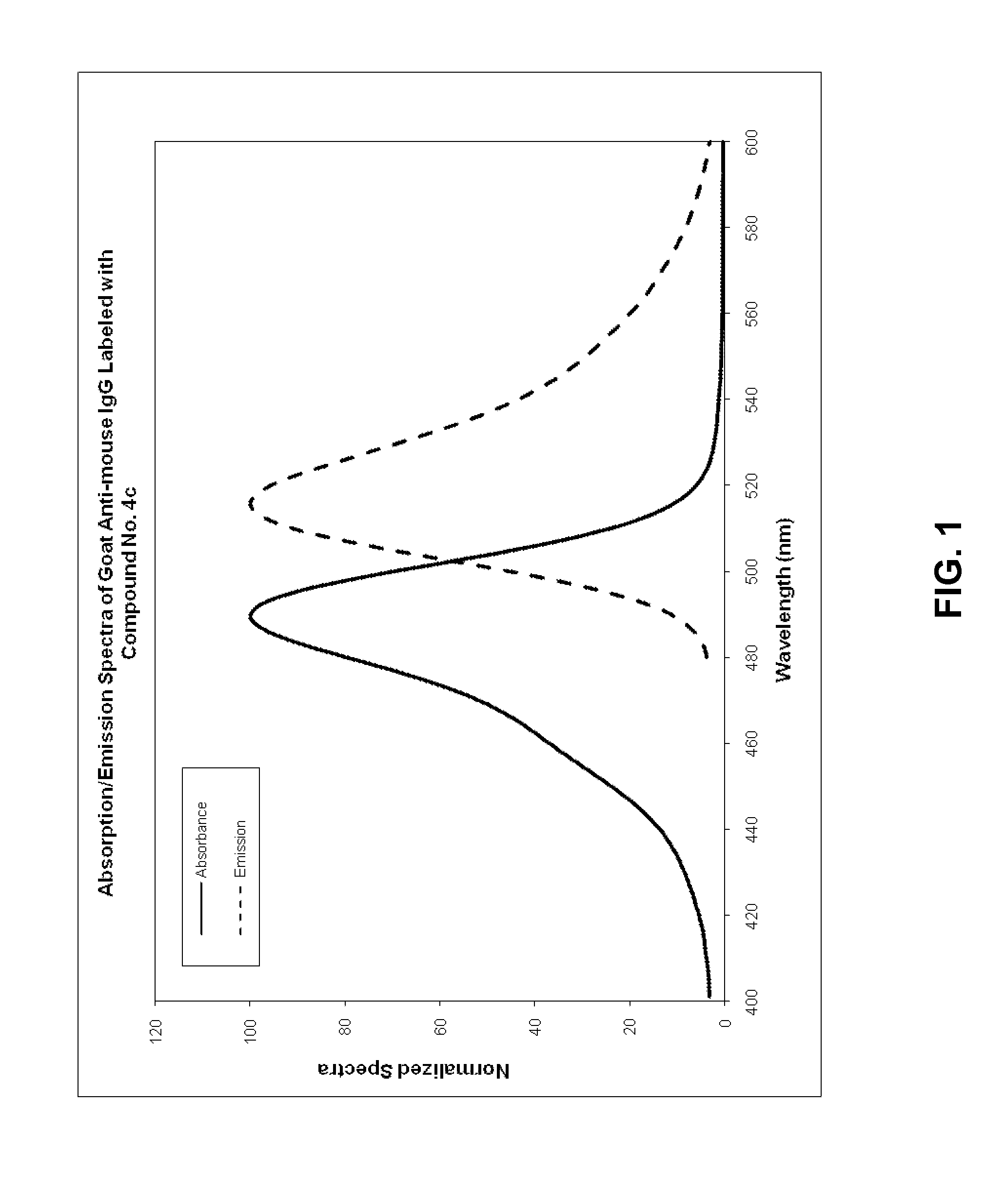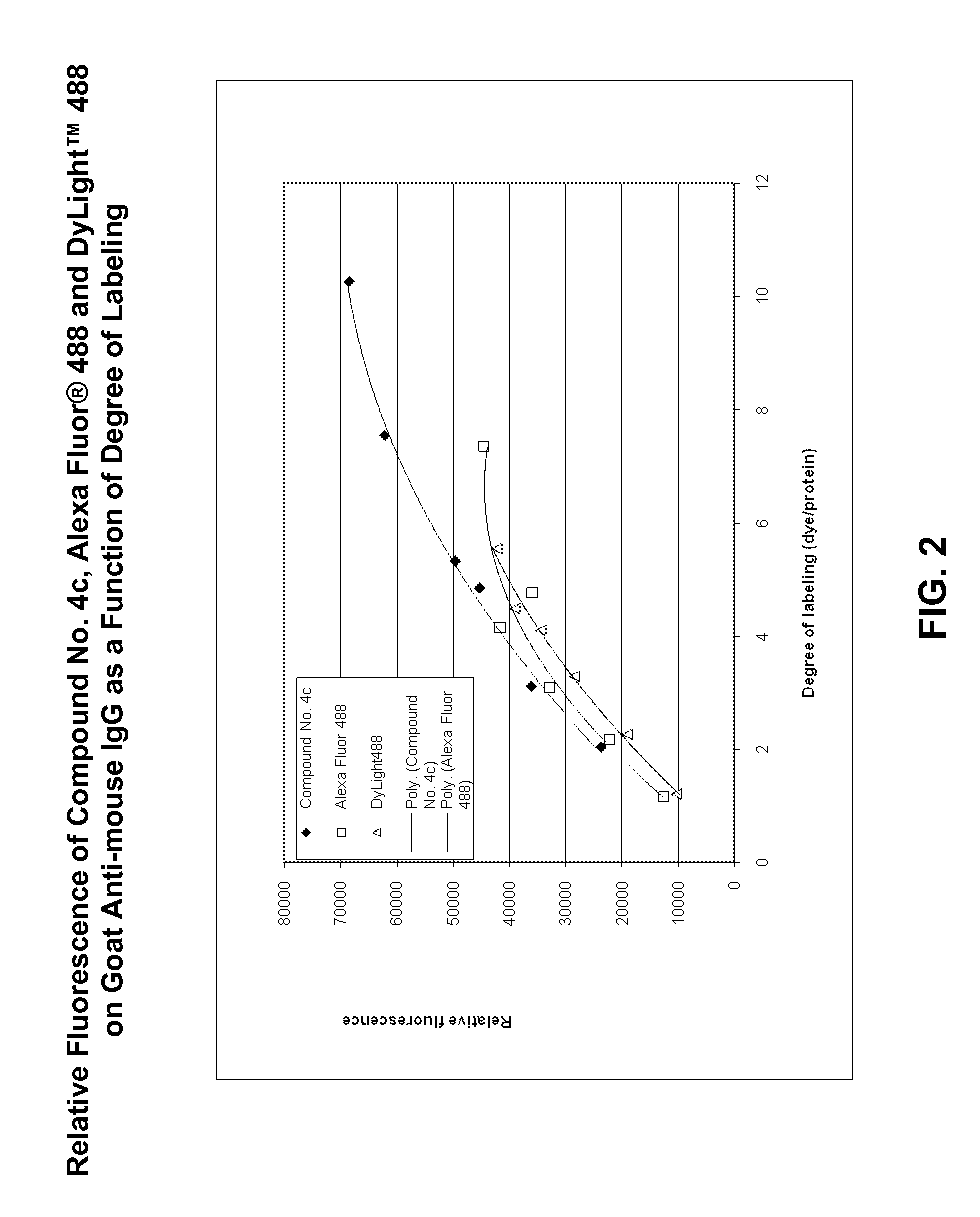Xanthene dyes comprising a sulfonamide group
a technology of sulfonamide and xanthene, which is applied in the field of xanthene, can solve the problems of reducing prone to inter-dye quenching of conventional fluorescent dyes, and affecting the effective brightness of dyes, so as to achieve convenient and effective labeling
- Summary
- Abstract
- Description
- Claims
- Application Information
AI Technical Summary
Benefits of technology
Problems solved by technology
Method used
Image
Examples
example 1
Preparation of Compound No. 1
[0426]
[0427]A mixture of methyl 6-aminohexanoate hydrochloride (10 g), 1,3-propanesulftone (7.4 g) and potassium carbonate (11.4 g) in CH3CN (200 mL) was stirred at room temperature for 2 days and then heated at 60° C. for 1 day. After cooling to room temperature, the mixture was suction filtered and the filtrate was concentrated to dryness in vacuo. To the residue was added EtOAc (200 mL) and the suspension was stirred at room temperature for 3 hrs. The precipitate was collected by suction filtration. The crude product was purified by a short silica gel column eluting with H2O / CH3 (20 g).
example 2
Preparation of Compound No. 2
[0428]
[0429]To compound No. 1 (5 g) in H2O (20 mL) was added a solution of NaOH (3.8 g) in H2O (20 mL). The mixture was stirred at room temperature for 2 hrs and the solution was neutralized to pH=7 with HCl (6 N) solution. The solution was concentrated to dryness in vacuo. The crude product was desalted though a short silica gel column using H2O / CH3CN as the eluent. The collected product was dried to a constant weight (3.5 g) under high vacuum.
example 3
Preparations of Compound No. 3a-6a
[0430]
[0431]A mixture of rhodamine 110 (0.2 g) (Biotium cat. #80103) in chlorosulfonic acid (3 mL) was heated at 40° C. for 2 hr and then cooled to room temperature. The solution was added dropwise slowly to a vigorously stirred crushed ice (80 g). The precipitate was suction filtered off and washed with cold water (2×5 mL) to give crude compound No. 3a, which was sufficiently pure for most subsequent conjugation reactions but could be made more stable for storage by immediate lyophilization. The above precipitate was cooled to 0° C. and a solution of the corresponding aminoalkyl acid (1 equivalent of H2N(CH2CH2O)8CH2CH2CO2H, cysteic acid, or compound No. 2) in a mixture of CH3CN (5 mL) and H2O (5 mL) containing Et3N (1 mL) was added. The mixture was stirred at 0° C. for 30 minutes and then at room temperature for 2 hrs. The solution was concentrated to dryness in vacuo and the crude product was purified by preparative HPLC using C18 reverse phase c...
PUM
 Login to View More
Login to View More Abstract
Description
Claims
Application Information
 Login to View More
Login to View More - R&D
- Intellectual Property
- Life Sciences
- Materials
- Tech Scout
- Unparalleled Data Quality
- Higher Quality Content
- 60% Fewer Hallucinations
Browse by: Latest US Patents, China's latest patents, Technical Efficacy Thesaurus, Application Domain, Technology Topic, Popular Technical Reports.
© 2025 PatSnap. All rights reserved.Legal|Privacy policy|Modern Slavery Act Transparency Statement|Sitemap|About US| Contact US: help@patsnap.com



